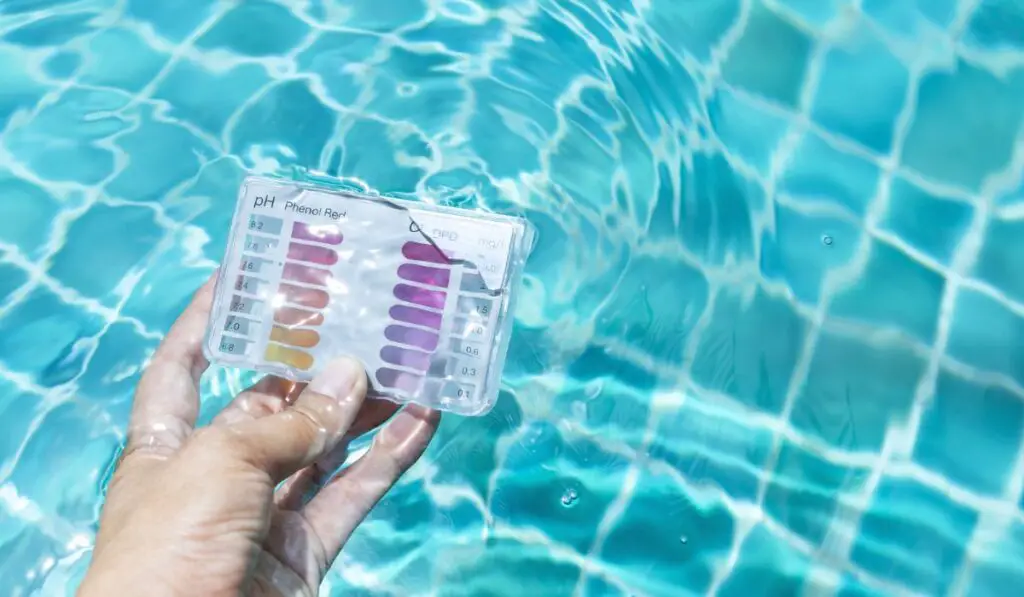Bubbles in your swimming pool look incredibly pretty, reflecting the sunlight and giving you a glimpse of all the colors of the rainbow as they pop on the surface of your pool water. But when these bubbles don’t burst and start to pile up to the point where your entire pool is covered with them, then you have a serious problem: pool foam.
You can fix a foamy pool by shocking it, balancing its chemical composition, or just adding antifoam chemicals. You can also directly remove the foam with a hand skimmer. It’s better to take some preventative measures as well, like enforcing a shower rule and using fragrance-free detergent.
While pool foam looks gross, there’s no need to freak out if your pool starts developing it. Fortunately, there are quick, easy solutions that can help you treat and prevent pool foam from taking over your entire pool. Let’s look at what exactly is pool foam and how you can treat and prevent it, so you know all the steps you need to take before your next pool party.
What Is Pool Foam?

At first glance, pool foam might just look like a lot of air bubbles in the water. But pool foam consists of much more than small air bubbles.
Pool foam is usually an indication of a high organic load in your pool water. This simply means that your pool has more organic material or contaminants than can be eliminated by sanitizer or dissolved in the water, resulting in “thickened” water.
It’s important to note that air bubbles are really light and can easily be popped with the slightest application of force. But with pool foam, it’s exactly the opposite.
Bubbles are formed when the water is disturbed by the pool’s return jets or even by a strong breeze. They’re full of air, but since their surface is made up of the buildup of organic material, they’re very difficult to pop. So, instead of bursting, they stay on the surface of the water and become foam.
And before we get too far, just know that diagnosing and fixing this is first going to require you to have a simple pool test kit or pool test strips (both on Amazon) to make sure you’re starting from a firm foundation of understanding if you pool is balanced or not, and what chemical adjustments it may need.
What Causes Pool Foam?
No matter how many times you clean your pool and keep the water perfectly balanced, you might still end up with a bit of pool foam. This is because the foam usually comes from innocuous sources, and might even be caused by the pool chemicals themselves.
Here are some of the most common reasons behind pool foam:
Chemicals
Maybe your pool water doesn’t have the chemical composition it should have. If your pool becomes too imbalanced, especially because of the sanitizer, then you might have to deal with foam in your pool.
The problem might also be because of cheap pool chemicals. This doesn’t mean that you should stop buying the least-expensive options from pool stores — those are perfectly safe to use. We’re talking about the chemicals you can bulk purchase from big-box chains that don’t really specialize in pool chemicals.
Those chemicals don’t usually meet the minimum standards for pool maintenance and might actually end up doing more damage by turning your pool into a foamy one.
Hygiene Products
The hygiene products that you use to rinse and wash can leave residue and debris behind. This is particularly true for the shower gels and soaps that claim to hydrate and moisturize your skin.
Swimsuits with lingering detergent can also cause pool foam. Skin and hair products and organic matter, such as saliva, urine, sweat, and body fat can result in foaming issues as well.
For this reason, it’s always better to rinse off before jumping into the pool to remove any oils, makeup, detergents, or shampoos. If you don’t enforce a showering rule, then all these contaminants will mix with the pool chemicals, resulting in a foamy pool.
Calcium And Algaecide
While chemicals are essential for proper pool care and maintenance, they can also result in foamy water, especially if you’ve just added them to the pool. Each chemical reacts differently with the pool water, but algaecide is usually what makes the water foamy.
It’s best to invest in a high-quality algaecide, preferably one that doesn’t have copper or any other unnecessary metallics. Make sure you’re also extra careful with the amount of algaecide you add and follow only the suggested doses, as too much algaecide can result in foaming as well.
Along with algaecide, low calcium levels are also an incredibly common reason behind pool foam. It’s important to keep the pool water balanced at all times, so that the level of calcium hardness doesn’t drop too low. If this happens, the water will become too soft, leading to foam production.
How To Get Rid Of Pool Foam
Luckily, it’s pretty easy to get rid of pool foam. Here are a few things you can do to successfully fix a foamy pool:
Use a Skimmer and Add Non-Foaming Algaecides
A hand skimmer can help remove most of the pool foam right away. And if you have balanced pool water, then the remaining foam should clear up quickly.
Since algaecides can also lead to a foamy pool, it’s better to opt for a non-foaming one. Try to avoid 10% copper and polymer-based algaecides because they cause foaming and might even stain the pool due to the metal content.
Balance The Pool Water
- Use a liquid test kit or test strips to test your pool water’s chemistry.
- Try balancing the alkalinity first. It’s best to keep it within the recommended range of 100 ppm to 140 ppm, with 125 parts per million being ideal.
- Balance your pool’s pH level. The recommended range is from 7.4 to 7.6, but try to aim for 7.5.
- Balance the level of calcium hardness. The recommended range for fiberglass and vinyl pools is from 175 ppm to 225 ppm, and from 200 ppm to 275 ppm for plaster and concrete pools.
- Balance your pool’s sanitizer level by following the instructions and recommended levels stated on the sanitizer you use.
Once you’ve added all the necessary chemicals, wait a couple of hours to see if the foam dissipates. If the problem still persists, then you’ll have to shock the pool.
Shock The Pool
If your pool has a perfectly balanced chemical composition, try shocking it with chlorine and then turn on the pump to see if that fixes the foam issue.
Shocking a pool essentially consists of adding large amounts of chlorine to the water to clean it. This process eliminates bacteria, contaminants, and cloudy or milky water. It also helps prevent ammonia, algae, and other living organisms from taking over your pool.
Increase Your Pool’s Calcium Hardness Level
You can fix a foamy pool by simply adding calcium chloride or a calcium hardness increaser to the water. Make sure you closely follow the instructions of the manufacturer and add only the required amount.
If the foam in your pool is caused by algaecide, then you don’t really need to do anything. Just wait a couple of days until it dissipates on its own.
Add Antifoam Chemicals
You can quickly get rid of the foam in your pool by using antifoam chemicals. They’re specifically designed to remove the pool foam without affecting the effectiveness of all the other chemicals in the water. Options like this Pool & Spa Defoamer (on Amazon) are a great place to start.
If you’ve tried all the aforementioned solutions, but the problem still persists, then it might be time to call a professional to assess the situation. They may be able to provide you with a solution that better combats the problem in your pool and help you get rid of foam once and for all.
Preventative Measures For Pool Foam

Prevention is always better and easier than finding a solution after experiencing the problem. Pool foam looks pretty gross and usually seems very difficult to deal with, but once you know exactly what to look for, you’ll be able to get rid of it in no time at all.
Along with keeping the chemical composition of your pool perfectly balanced, here are a few other preventative measures you can take to ensure you don’t have to deal with pesky pool foam ever again:
- Take a shower before jumping into the pool, and make sure you thoroughly rinse your hair as well. If you’ve used a lot of hair care products, such as paste, hairspray, or mousse, actually shampooing it and then rinsing it off is even better.
- Eliminate or change some of the detergents and soaps you use to clean your clothes. Try to opt for fragrance-free laundry detergents or other “green” options that use fewer ingredients and are comparatively environmentally friendlier.
- Replace fabric softener with white vinegar to soften all your clothes.
- Regularly test the water and ensure it’s balanced at all times. Also, keep a close eye on the calcium hardness level and don’t let it drop below the recommended level.
- Purchase all your pool chemicals from recognized, reputable brands, or from a pool maintenance professional or pool store.
